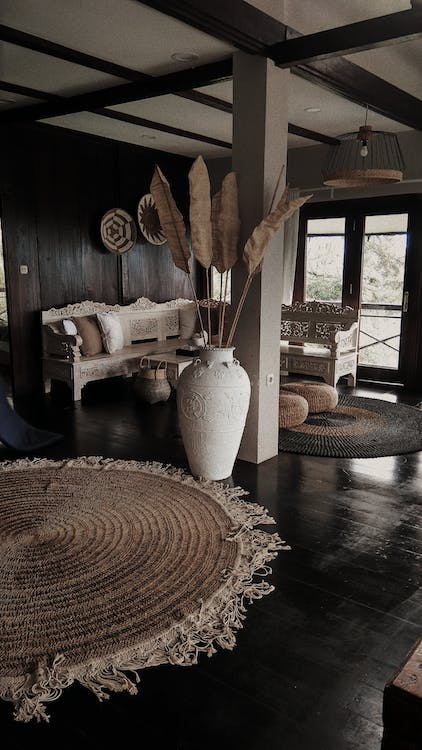How to Arrange a Living Room - Designer Tips & Ideas

It’s crucial to understand living room design. After all, the living room serves as the actual or metaphorical focal point of our houses. Every member of the family uses them every day, but we also invite visitors and relatives into these rooms.
Living room designer tips and ideas require deliberate and knowledgeable design despite not having the same design requirements as kitchens due to their dual function as family and entertaining spaces and the amount of time we spend there.
Your living room should be a place where you can relax, let down your guard, and spend quality time with friends, family, or just yourself, regardless of whether your style is traditional or modern, easygoing or formal, vibrant or muted. Decorating a space so that it looks fantastic and serves your needs well takes skill. So ready yourself with a few design ideas and methods before you and your pro plunge into a living room renovation.
Measure the Area and the Furniture
You’re almost ready to begin organizing your furniture arrangement once you’ve chosen a focal wall and determined the function of your area. But before you do that, our designers advise you to measure the room and any furniture you intend to place in it.
Take this chance to make a list of the furniture you now have and the furnishings you’re considering getting for the room. Take note of the dimensions of the furniture you want in your new room if you intend to replace or purchase new items.
It’s usually a good idea to measure your 3D room design and your furnishings before bringing them into your house, but this step is crucial if your living room is smaller than usual, has low ceilings, or is shaped differently from other rooms.
Layout the Living Room in Advance
Getting a piece of graph paper with each square denoting one square foot and planning the layout on it is one option. To represent the room’s walls, outline the space. Shapes for the furniture should be cut out of another sheet of graph paper. To test how well the furniture fits and how it seems in various situations, place those pieces over the contour of your space. To show where you want to place each piece of furniture, you can also use masking tape or another removable object, like a stack of books, in the room itself.
It could be tempting to purchase your furniture before determining how it will fit in your living area. To obtain a sense of how the furniture will fit in the space, we advise writing down the measurements of the items you want and then using the layout sketching or tape ideas.
When designing a living space, the texture is simple to miss because we don’t see it as much as touch it. However, velvety textures that are appealing to the touch and rougher textures that offer contrast are vital for creating a warm atmosphere in a living area. Include as many different textures as you can, such as leather, cotton, wool, metal, stone, glass, and plant life.
If you’re designing a living room on a tight budget, pillows are a wonderful place to start. If you want to introduce additional materials to the palette, even in tiny amounts, look to other accents and furniture.
Determine the Function of the Room
The living room can serve as the hub of the house and the main gathering place for your family, depending on your lifestyle and the design of your house. Or it might be a location designated for receiving visitors. Do you want to utilize the space to hold Super Bowl parties, amuse your kids, relax, or do all of the above? The optimal arrangement will depend on your objectives for the space.
For instance, the television should be the center of attention and be visible from every seat if you and your family plan to use the space mostly to watch TV. Place sofas and chairs facing one another to encourage discussion if it’s intended to be a place for catching up with friends. Families with small children might wish to provide many storage choices, such as a sideboard or storage basket, for toys or blankets.
Benefit from the Space Between Things
Don’t feel pressured to maximize every square inch of your new living room setup. Be as deliberate with your space as you are with the arrangement of your furnishings. You’ll not only have improved traffic flow, but your space will also seem more balanced and airy.
In reality, minimalist furnishings and purposeful space work best in rooms with limited space, such as those with low or sloping ceilings. Pick a few contemporary or minimalist pieces that won’t take up much room or generate a lot of competing focal points.
Browse Furniture By Size, Purpose, and Style
Consider who will use the furniture and how it will be utilized before you purchase any items. Your choice of materials or styles can be influenced by this. For instance, if you know that the item will be used regularly by children or dogs, you may want to choose a sturdy, scratch- or stain-resistant sofa material.
A massive sofa will always feel out of place in a small space, and a small chair will always feel out of place in a big room. If you decide to incorporate a rug in your plan, be sure it covers the area of the floor occupied by the other pieces of furniture. Make an effort to place at least the front legs of your sofas or chairs directly on the carpeting.
You want the furnishings and décor in your home to flow together. Buy furniture that won’t conflict with the designs or materials of your existing furniture and decor.
